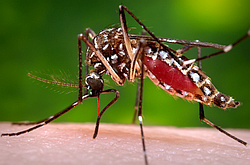Fight the Bite: Avoiding Vector-Borne Disease - Update
Published Date: Jun 07

 image by James Gathany
As warmer weather nears, it is important to remain vigilant in preventing tick- and mosquito-borne diseases as you plan your outdoor excursions.
image by James Gathany
As warmer weather nears, it is important to remain vigilant in preventing tick- and mosquito-borne diseases as you plan your outdoor excursions.
Along with the continued risk of contracting diseases already established in the U.S., climate change and increased globalization are expanding the geographical range of key vectors, such as the mosquito species that transmit chikungunya and zika virus.
Most vector-borne diseases have no cure so, when traveling into your back yard or beyond you’re only left with the choice of an ounce or a pound of prevention.
Fortunately, we can all take steps such as:
The CDC also provides educational information on approved repellents and other methods for preventing tick and mosquito bites.
EH&S Safety Short: Fight the Bite

Along with the continued risk of contracting diseases already established in the U.S., climate change and increased globalization are expanding the geographical range of key vectors, such as the mosquito species that transmit chikungunya and zika virus.
Most vector-borne diseases have no cure so, when traveling into your back yard or beyond you’re only left with the choice of an ounce or a pound of prevention.
Fortunately, we can all take steps such as:
- use an effective insect repellent on skin and clothing
- wear long sleeves and long pants (when it's not too hot)
- take care of our yards to get rid of standing water where mosquitoes lay their eggs
- reduce brush, tall grasses, leaf litter, and harborage where ticks may like to hang out
The CDC also provides educational information on approved repellents and other methods for preventing tick and mosquito bites.
EH&S Safety Short: Fight the Bite
Fireworks Safety for the Fourth
Published Date: Jun 27
 Each Fourth of July, many celebrate the holiday with barbeque, parties, boating, and generally having fun. It is, after all, a celebration of the country's independence. After the sun has set and the day's parties are winding down, another round of celebration cranks up by shooting off fireworks.
Each Fourth of July, many celebrate the holiday with barbeque, parties, boating, and generally having fun. It is, after all, a celebration of the country's independence. After the sun has set and the day's parties are winding down, another round of celebration cranks up by shooting off fireworks.
Enjoy the celebration of our country's independence but do so safely and responsibly. The misuse of fireworks account for a significant number of emergency room visits. Make sure you are around to see them this year and in the future.
View the Fireworks Safety Checklist

Enjoy the celebration of our country's independence but do so safely and responsibly. The misuse of fireworks account for a significant number of emergency room visits. Make sure you are around to see them this year and in the future.
View the Fireworks Safety Checklist
Halloween Safety
Published Date: Oct 27
While planning your Halloween activities and choosing costumes for your children, keep in mind some safety tips to avoid injury.
According to the National Safe Kids Campaign, children are twice as likely to be hit by a car and killed on Halloween than any other day of the year. There is also an increase in burns and falls during Halloween activities. Make note of the Safe Kids Halloween Safety tips.
To avoid falls from cumbersome costumes, dangerous treats, and risky activity on Halloween night, the Alabama Department of Public Health recommends parents and children follow these safety tips.
According to the National Safe Kids Campaign, children are twice as likely to be hit by a car and killed on Halloween than any other day of the year. There is also an increase in burns and falls during Halloween activities. Make note of the Safe Kids Halloween Safety tips.
To avoid falls from cumbersome costumes, dangerous treats, and risky activity on Halloween night, the Alabama Department of Public Health recommends parents and children follow these safety tips.
